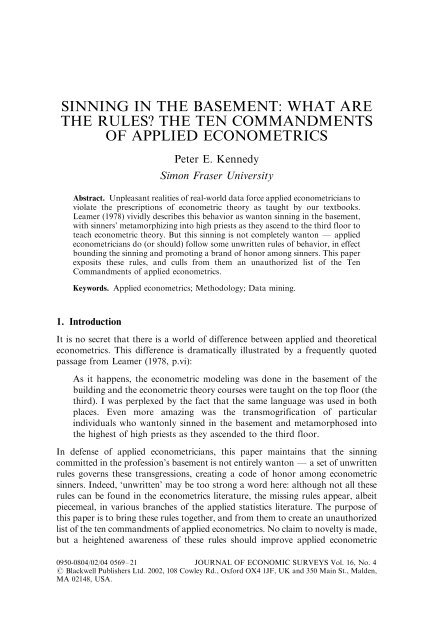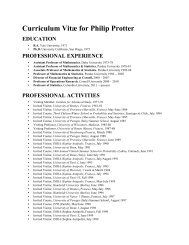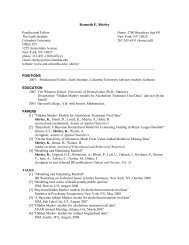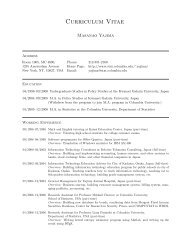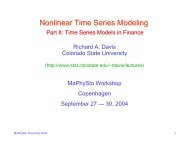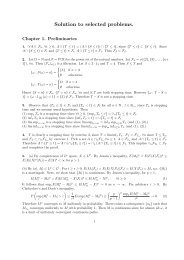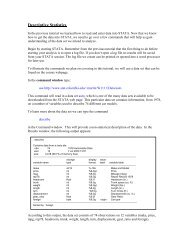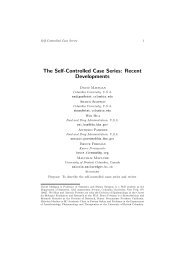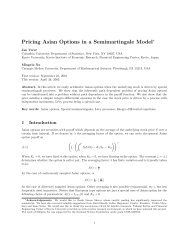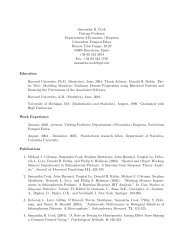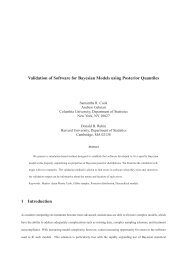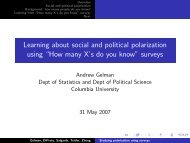sinning in the basement: what are the rules? the ten commandments ...
sinning in the basement: what are the rules? the ten commandments ...
sinning in the basement: what are the rules? the ten commandments ...
Create successful ePaper yourself
Turn your PDF publications into a flip-book with our unique Google optimized e-Paper software.
SINNING IN THE BASEMENT: WHAT ARE<br />
THE RULES? THE TEN COMMANDMENTS<br />
OF APPLIED ECONOMETRICS<br />
Peter E. Kennedy<br />
Simon Fraser University<br />
Abstract. Unpleasant realities of real-world data force applied econometricians to<br />
violate <strong>the</strong> prescriptions of econometric <strong>the</strong>ory as taught by our textbooks.<br />
Leamer (1978) vividly describes this behavior as wanton <strong>s<strong>in</strong>n<strong>in</strong>g</strong> <strong>in</strong> <strong>the</strong> <strong>basement</strong>,<br />
with s<strong>in</strong>ners’ metamorphiz<strong>in</strong>g <strong>in</strong>to high priests as <strong>the</strong>y ascend to <strong>the</strong> third floor to<br />
teach econometric <strong>the</strong>ory. But this <strong>s<strong>in</strong>n<strong>in</strong>g</strong> is not completely wanton — applied<br />
econometricians do (or should) follow some unwrit<strong>ten</strong> <strong>rules</strong> of behavior, <strong>in</strong> effect<br />
bound<strong>in</strong>g <strong>the</strong> <strong>s<strong>in</strong>n<strong>in</strong>g</strong> and promot<strong>in</strong>g a brand of honor among s<strong>in</strong>ners. This paper<br />
exposits <strong>the</strong>se <strong>rules</strong>, and culls from <strong>the</strong>m an unauthorized list of <strong>the</strong> Ten<br />
Commandments of applied econometrics.<br />
Keywords. Applied econometrics; Methodology; Data m<strong>in</strong><strong>in</strong>g.<br />
1. Introduction<br />
It is no secret that <strong>the</strong>re is a world of difference between applied and <strong>the</strong>oretical<br />
econometrics. This difference is dramatically illustrated by a frequently quoted<br />
passage from Leamer (1978, p.vi):<br />
As it happens, <strong>the</strong> econometric model<strong>in</strong>g was done <strong>in</strong> <strong>the</strong> <strong>basement</strong> of <strong>the</strong><br />
build<strong>in</strong>g and <strong>the</strong> econometric <strong>the</strong>ory courses were taught on <strong>the</strong> top floor (<strong>the</strong><br />
third). I was perplexed by <strong>the</strong> fact that <strong>the</strong> same language was used <strong>in</strong> both<br />
places. Even more amaz<strong>in</strong>g was <strong>the</strong> transmogrification of particular<br />
<strong>in</strong>dividuals who wantonly s<strong>in</strong>ned <strong>in</strong> <strong>the</strong> <strong>basement</strong> and metamorphosed <strong>in</strong>to<br />
<strong>the</strong> highest of high priests as <strong>the</strong>y ascended to <strong>the</strong> third floor.<br />
In defense of applied econometricians, this paper ma<strong>in</strong>ta<strong>in</strong>s that <strong>the</strong> <strong>s<strong>in</strong>n<strong>in</strong>g</strong><br />
committed <strong>in</strong> <strong>the</strong> profession’s <strong>basement</strong> is not entirely wanton — a set of unwrit<strong>ten</strong><br />
<strong>rules</strong> governs <strong>the</strong>se transgressions, creat<strong>in</strong>g a code of honor among econometric<br />
s<strong>in</strong>ners. Indeed, ‘unwrit<strong>ten</strong>’ may be too strong a word here: although not all <strong>the</strong>se<br />
<strong>rules</strong> can be found <strong>in</strong> <strong>the</strong> econometrics literature, <strong>the</strong> miss<strong>in</strong>g <strong>rules</strong> appear, albeit<br />
piecemeal, <strong>in</strong> various branches of <strong>the</strong> applied statistics literature. The purpose of<br />
this paper is to br<strong>in</strong>g <strong>the</strong>se <strong>rules</strong> toge<strong>the</strong>r, and from <strong>the</strong>m to create an unauthorized<br />
list of <strong>the</strong> <strong>ten</strong> <strong>commandments</strong> of applied econometrics. No claim to novelty is made,<br />
but a heigh<strong>ten</strong>ed aw<strong>are</strong>ness of <strong>the</strong>se <strong>rules</strong> should improve applied econometric<br />
0950-0804/02/04 0569–21 JOURNAL OF ECONOMIC SURVEYS Vol. 16, No. 4<br />
# Blackwell Publishers Ltd. 2002, 108 Cowley Rd., Oxford OX4 1JF, UK and 350 Ma<strong>in</strong> St., Malden,<br />
MA 02148, USA.
570 KENNEDY<br />
work, prompt <strong>in</strong>structors to <strong>in</strong>corporate <strong>the</strong>m <strong>in</strong>to applied econometrics courses,<br />
and conv<strong>in</strong>ce textbook authors to add <strong>the</strong>m to new editions. 1<br />
These <strong>rules</strong> <strong>are</strong> fundamental to do<strong>in</strong>g compe<strong>ten</strong>t applied econometric work, so<br />
fundamental that to avoid misunderstand<strong>in</strong>g it is necessary to beg<strong>in</strong> by offer<strong>in</strong>g<br />
some perspective on where <strong>the</strong>y fit <strong>in</strong> <strong>the</strong> hierarchy of econometric material. In<br />
Leamer’s metaphor, econometric <strong>the</strong>ory is taught on <strong>the</strong> third floor. This consists<br />
of th<strong>in</strong>gs like prov<strong>in</strong>g <strong>the</strong> Gauss-Markov <strong>the</strong>orem, deriv<strong>in</strong>g <strong>the</strong> Cramer-Rao lower<br />
bound, and teach<strong>in</strong>g <strong>the</strong> details of asymptotics. Theorem-prov<strong>in</strong>g and algebraic<br />
derivations def<strong>in</strong>e this floor.<br />
From <strong>the</strong> po<strong>in</strong>t of view of applied econometricians <strong>the</strong>re <strong>are</strong> several concerns<br />
with this third-floor activity. Leamer (1988) compla<strong>in</strong>s that <strong>the</strong>re is too much<br />
asymptotics, and that reliance on asymptotics is very dangerous <strong>in</strong> applied<br />
econometrics — practitioners work with f<strong>in</strong>ite sample sizes, for which asymptotic<br />
results can mislead. Worswick (1972, p. 79) compla<strong>in</strong>s that<br />
Econometricians <strong>are</strong> not, it seems to me, engaged <strong>in</strong> forg<strong>in</strong>g tools to arrange<br />
and measure actual facts so much as mak<strong>in</strong>g a marvelous array of pre<strong>ten</strong>dtools<br />
which would perform wonders if ever a set of facts should turn up <strong>in</strong> <strong>the</strong><br />
right form.<br />
The implication of such compla<strong>in</strong>ts for applied econometricians is best expressed<br />
by Pagan’s (1999, p. 374) story of <strong>the</strong> Zen master and his student, conclud<strong>in</strong>g<br />
that<br />
It’s not <strong>what</strong> you know about someth<strong>in</strong>g that is important, but ra<strong>the</strong>r how<br />
you use it.<br />
On <strong>the</strong> second floor we move <strong>in</strong>to <strong>the</strong> world of applied econometrics, <strong>in</strong> which<br />
students <strong>are</strong> taught, <strong>in</strong> hands-on fashion, how to undertake a wide variety of<br />
advanced econometric techniques, such as test<strong>in</strong>g for unit roots and co<strong>in</strong>tegration,<br />
correct<strong>in</strong>g for sample selection bias, perform<strong>in</strong>g Hausman tests, and estimat<strong>in</strong>g<br />
us<strong>in</strong>g Tobit, Poisson, and ordered probit models. To follow Pagan’s Zen master<br />
story, this is about us<strong>in</strong>g <strong>the</strong> third-floor results, but at an advanced level — <strong>the</strong><br />
focus is on techniques, not <strong>the</strong> basics that def<strong>in</strong>e <strong>basement</strong> activity. To many, such<br />
as Chatfield (1991, p. 247), this appears odd:<br />
It is unfortunate that most textbooks concentrate on <strong>the</strong> easy estimation<br />
stage, when trouble is more likely to occur at <strong>the</strong> earlier specification stage.<br />
Intriligator, Bodk<strong>in</strong> and Hsiao (1996, p.xiv) agree:<br />
At least 80% of <strong>the</strong> material <strong>in</strong> most of <strong>the</strong> exist<strong>in</strong>g textbooks <strong>in</strong> econometrics<br />
focuses purely on econometric techniques. By contrast, practic<strong>in</strong>g econometricians<br />
typically spend 20% or less of <strong>the</strong>ir time and effort on econometric<br />
techniques per se; <strong>the</strong> rema<strong>in</strong>der is spent on o<strong>the</strong>r aspects of <strong>the</strong> study,<br />
particularly on <strong>the</strong> construction of a relevant econometric model and <strong>the</strong><br />
development of appropriate data before estimation and <strong>the</strong> <strong>in</strong>terpretation of<br />
results after estimation.<br />
# Blackwell Publishers Ltd. 2002
APPLIED ECONOMETRICS 571<br />
Mov<strong>in</strong>g down to <strong>the</strong> first floor, we f<strong>in</strong>d econometrics courses of a more<br />
elementary nature, cover<strong>in</strong>g <strong>the</strong>oretical and applied topics such as <strong>the</strong> use and<br />
<strong>in</strong>terpretation of dummy variables, <strong>the</strong> logic of F and chi-squ<strong>are</strong> tests, and test<strong>in</strong>g<br />
and correct<strong>in</strong>g for nonspherical errors. On this floor, as on <strong>the</strong> higher floors, a<br />
common compla<strong>in</strong>t (Wild, 1994; Chatfield, 1995a) is that teach<strong>in</strong>g is techniqueoriented<br />
ra<strong>the</strong>r than problem-oriented. In Bailar’s (1988, p. 7) words, <strong>in</strong>structors<br />
‘were not teach<strong>in</strong>g statistical reason<strong>in</strong>g. They were teach<strong>in</strong>g mechanical<br />
manipulations’. An exam<strong>in</strong>ation of typical econometrics textbooks does little to<br />
dispel this view — assignments <strong>in</strong> <strong>the</strong>se texts ma<strong>in</strong>ly set students up to apply a<br />
technique, ra<strong>the</strong>r than creat<strong>in</strong>g for <strong>the</strong>m a real-world scenario <strong>in</strong> which,<br />
undirected, <strong>the</strong>y must address an empirical issue.<br />
Judg<strong>in</strong>g by our econometrics textbooks, <strong>the</strong> first floor is <strong>the</strong> bottom floor of <strong>the</strong><br />
econometrics build<strong>in</strong>g — <strong>the</strong>re is no floor below this, only a separate build<strong>in</strong>g<br />
hous<strong>in</strong>g <strong>in</strong>troductory statistics courses. But <strong>what</strong> about <strong>the</strong> <strong>basement</strong> of <strong>the</strong><br />
econometrics build<strong>in</strong>g? Accord<strong>in</strong>g to Leamer, this is where real-world econometric<br />
model<strong>in</strong>g is done. Does <strong>what</strong> we teach on <strong>the</strong> upper floors adequately<br />
prep<strong>are</strong> students for work<strong>in</strong>g <strong>in</strong> <strong>the</strong> <strong>basement</strong>? One <strong>the</strong>me of this paper is that our<br />
students <strong>are</strong> not well prep<strong>are</strong>d for real-world econometric work. We do not alert<br />
<strong>the</strong>m to <strong>the</strong> true fundamentals of do<strong>in</strong>g applied work (<strong>the</strong> ‘<strong>rules</strong> for <strong>s<strong>in</strong>n<strong>in</strong>g</strong>’),<br />
prerequisites for successful application of <strong>the</strong> concepts and techniques <strong>the</strong>y learn<br />
on o<strong>the</strong>r floors.<br />
It is not hard to f<strong>in</strong>d rumbl<strong>in</strong>gs of discon<strong>ten</strong>t among applied econometricians<br />
regard<strong>in</strong>g <strong>the</strong> way <strong>in</strong> which <strong>the</strong> subject is taught. Magnus (1999, p. 60) identifies a<br />
major concern:<br />
My worry as an econometric <strong>the</strong>orist is not that <strong>the</strong>re is <strong>ten</strong>sion between us<br />
(<strong>the</strong> <strong>the</strong>orists) and <strong>the</strong>m (<strong>the</strong> applied economists). On <strong>the</strong> contrary, such<br />
<strong>ten</strong>sion can be healthy and <strong>in</strong>spir<strong>in</strong>g. My worry is ra<strong>the</strong>r <strong>the</strong> lack of <strong>ten</strong>sion.<br />
There <strong>are</strong> two camps, a gap between <strong>the</strong>m, and little communication.<br />
Magnus and Morgan (1999, p. 379) conclude that ‘There is clearly a big problem<br />
of middle-level <strong>in</strong>struction’. And Wooldridge (2000, p. iii), notes ‘There is a<br />
widen<strong>in</strong>g gap between <strong>the</strong> way <strong>in</strong> which <strong>in</strong>troductory econometrics is taught and<br />
<strong>the</strong> way empirical researchers th<strong>in</strong>k about, apply, and <strong>in</strong>terpret econometric<br />
methods’. These compla<strong>in</strong>ts <strong>are</strong> directed more at first-and second-floor activity<br />
than at <strong>basement</strong> activity. In contrast, this paper focuses on <strong>the</strong> <strong>basement</strong>,<br />
propos<strong>in</strong>g <strong>rules</strong> of applied econometrics behavior that will annoy econometricians<br />
— <strong>the</strong>y will view <strong>the</strong>se <strong>rules</strong> as ei<strong>the</strong>r unteachable 2 or so elementary that both<br />
undergraduate and graduate students surely will have learned <strong>the</strong>m at an earlier<br />
stage <strong>in</strong> <strong>the</strong>ir academic c<strong>are</strong>er. Readers can judge <strong>the</strong> former issue for <strong>the</strong>mselves;<br />
my op<strong>in</strong>ion is that regardless of teachability, we have a moral obligation to <strong>in</strong>form<br />
students of <strong>the</strong>se <strong>rules</strong>, and, through suitable assignments, socialize <strong>the</strong>m to<br />
<strong>in</strong>corporate <strong>the</strong>m <strong>in</strong>to <strong>the</strong> standard operat<strong>in</strong>g procedures <strong>the</strong>y follow when do<strong>in</strong>g<br />
empirical work. On <strong>the</strong> latter issue, my many years of experience teach<strong>in</strong>g,<br />
practic<strong>in</strong>g, supervis<strong>in</strong>g, referee<strong>in</strong>g and edit<strong>in</strong>g applied econometrics (but not my<br />
read<strong>in</strong>g of econometrics textbooks!) have led me to believe that <strong>the</strong>se <strong>rules</strong> <strong>are</strong> far<br />
# Blackwell Publishers Ltd. 2002
572 KENNEDY<br />
more important than <strong>in</strong>structors believe, and that students at all levels do not<br />
accord <strong>the</strong>m <strong>the</strong> respect <strong>the</strong>y deserve. Magnus and Morgan (1999a, p. 1) claim<br />
that ‘<strong>the</strong> establishment of a credible applied econometrics is possibly <strong>the</strong> most<br />
important task of econometrics today’. Identify<strong>in</strong>g <strong>the</strong> ‘<strong>rules</strong> of <strong>s<strong>in</strong>n<strong>in</strong>g</strong>’ is surely a<br />
prerequisite to mov<strong>in</strong>g <strong>the</strong> profession <strong>in</strong> this direction. 3<br />
2. The Rules of S<strong>in</strong>n<strong>in</strong>g<br />
Rule #1: Use common sense and economic <strong>the</strong>ory.<br />
The reason for this rule is that common sense is not all that common. Indeed,<br />
sometimes it appears that not much thought has gone <strong>in</strong>to empirical work, let<br />
alone good thought, as Preece (1987, p. 397) emphasizes:<br />
The procedures of good statistical practice <strong>are</strong> founded on experience and<br />
commonsense; it is good practice to stop and th<strong>in</strong>k before runn<strong>in</strong>g a<br />
regression.<br />
Such th<strong>in</strong>k<strong>in</strong>g does not need to <strong>in</strong>volve complicated econometrics, as is evident <strong>in</strong><br />
this commentary from Trosset (1998, p. 23):<br />
I was struck by how of<strong>ten</strong> I provided a service without do<strong>in</strong>g anyth<strong>in</strong>g that an<br />
academic researcher would recognize as statistics. Time and aga<strong>in</strong> I was<br />
thanked (and paid) for ask<strong>in</strong>g questions and suggest<strong>in</strong>g perspectives that<br />
seemed to me to be little more than common sense. This highly developed<br />
common sense is an easily overlooked, but extraord<strong>in</strong>arily valuable commodity.<br />
In <strong>the</strong> econometric context, this th<strong>in</strong>k<strong>in</strong>g should cause researchers to match per<br />
capita variables with per capita variables, use real exchange rates to expla<strong>in</strong> real<br />
imports=exports, employ nom<strong>in</strong>al <strong>in</strong>terest rates to expla<strong>in</strong> real money demand,<br />
select appropriate functional forms for dependent variables constra<strong>in</strong>ed to lie<br />
between zero and one, resist try<strong>in</strong>g to expla<strong>in</strong> a trendless variable with a trended<br />
variable, avoid card<strong>in</strong>aliz<strong>in</strong>g ordered qualitative explanatory variables, bew<strong>are</strong> of<br />
<strong>the</strong> regression fallacy (Friedman, 1992), and never <strong>in</strong>fer causation from correlation.<br />
Hotell<strong>in</strong>g et al. (1948, p. 103) have captured <strong>the</strong> essence of this rule nicely:<br />
Unfortunately, too many people like to do <strong>the</strong>ir statistical work as <strong>the</strong>y say<br />
<strong>the</strong>ir prayers — merely substitute <strong>in</strong> a formula found <strong>in</strong> a highly respected<br />
book.<br />
Rule #2: Avoid type III errors.<br />
A type III error, <strong>in</strong>troduced <strong>in</strong> Kimball (1957), occurs when a researcher produces<br />
<strong>the</strong> right answer to <strong>the</strong> wrong question. 4 A corollary of this rule, as noted by<br />
Chatfield (1995, p. 9), is that an approximate answer to <strong>the</strong> right question is worth<br />
a great deal more than a precise answer to <strong>the</strong> wrong question. Tukey (1962,<br />
p. 13–14) states this <strong>in</strong> a more accusatory fashion:<br />
Far better an approximate answer to <strong>the</strong> right question, which is of<strong>ten</strong> vague,<br />
than an exact answer to <strong>the</strong> wrong question, which can always be made precise.<br />
# Blackwell Publishers Ltd. 2002
APPLIED ECONOMETRICS 573<br />
The phenomenon at issue here is that <strong>the</strong> relevant objective=hypo<strong>the</strong>sis=<br />
specification may be completely different from <strong>what</strong> is <strong>in</strong>itially suggested.<br />
Econometricians experience this regularly when colleagues or students stop by for<br />
advice, prefac<strong>in</strong>g <strong>the</strong>ir request with words to <strong>the</strong> effect that <strong>the</strong>y do not want to<br />
take up much of <strong>the</strong> econometrician’s time so <strong>the</strong>y will expla<strong>in</strong> just <strong>the</strong> technical<br />
detail with which <strong>the</strong>y want help. Acquiesc<strong>in</strong>g to this is usually a mistake, as<br />
articulated by Jo<strong>in</strong>er (1982, p. 333)<br />
We found repeatedly that simple questions about seem<strong>in</strong>gly m<strong>in</strong>or details<br />
of<strong>ten</strong> br<strong>in</strong>g to light misunderstand<strong>in</strong>gs of important issues.<br />
Magnus (1999, pp. 56–7) offers an example, and op<strong>in</strong>es that ‘ask<strong>in</strong>g <strong>the</strong> right<br />
question is a non-trivial and difficult aspect of research’.<br />
The ma<strong>in</strong> lesson here is a blunt one: Ask questions, especially seem<strong>in</strong>gly foolish<br />
questions, to ensure that you have a full understand<strong>in</strong>g of <strong>the</strong> context of <strong>the</strong><br />
‘technical detail’ be<strong>in</strong>g discussed; of<strong>ten</strong> it turns out that your colleague has not<br />
formulated her=his research question appropriately.<br />
Rule #3: Know <strong>the</strong> context.<br />
This rule is a natural ex<strong>ten</strong>sion of <strong>the</strong> previous rule. It is crucial that one become<br />
<strong>in</strong>timately familiar with <strong>the</strong> phenomenon be<strong>in</strong>g <strong>in</strong>vestigated — its history,<br />
<strong>in</strong>stitutions, operat<strong>in</strong>g constra<strong>in</strong>ts, measurement peculiarities, cultural customs,<br />
and so on, go<strong>in</strong>g beyond a thorough literature review. As Zellner (1992)<br />
emphasizes, ‘GET THE FACTS’. Aga<strong>in</strong>, questions must be asked: Exactly how<br />
were <strong>the</strong> data ga<strong>the</strong>red? Did government agencies impute <strong>the</strong> data us<strong>in</strong>g unknown<br />
formulas? What were <strong>the</strong> <strong>rules</strong> govern<strong>in</strong>g <strong>the</strong> auction? How were <strong>the</strong> <strong>in</strong>terviewees<br />
selected? What <strong>in</strong>structions were given to <strong>the</strong> participants? What account<strong>in</strong>g<br />
conventions were followed? How were <strong>the</strong> variables def<strong>in</strong>ed? What is <strong>the</strong> precise<br />
word<strong>in</strong>g of <strong>the</strong> questionnaire? How closely do measured variables match <strong>the</strong>ir<br />
<strong>the</strong>oretical counterparts?<br />
Data <strong>are</strong> numbers with a context (Moore, 1990); know <strong>the</strong> context! Tweedie et<br />
al. (1998) and Pfannkuch and Wild (2000) provide examples of how a c<strong>are</strong>ful<br />
exam<strong>in</strong>ation of <strong>the</strong> data-generat<strong>in</strong>g procedure has led to substantive <strong>in</strong>sights.<br />
Burdek<strong>in</strong> and Burkett (1998) and Wilcox (1992) <strong>are</strong> examples of how not know<strong>in</strong>g<br />
<strong>the</strong> context can lead to error.<br />
Belsley and Welch (1988, p. 447) have summarized this neatly:<br />
Don’t try to model without understand<strong>in</strong>g <strong>the</strong> nonstatistical aspects of <strong>the</strong><br />
real-life system you <strong>are</strong> try<strong>in</strong>g to subject to statistical analysis. Statistical<br />
analysis done <strong>in</strong> ignorance of <strong>the</strong> subject matter is just that — ignorant<br />
statistical analysis.<br />
Rule #4: Inspect <strong>the</strong> data.<br />
Even if a researcher knows <strong>the</strong> context, s=he needs to become <strong>in</strong>timately familiar<br />
with <strong>the</strong> specific data with which s=he is work<strong>in</strong>g. Economists <strong>are</strong> particularly<br />
prone to <strong>the</strong> compla<strong>in</strong>t that researchers do not know <strong>the</strong>ir data very well, a<br />
# Blackwell Publishers Ltd. 2002
574 KENNEDY<br />
phenomenon made worse by <strong>the</strong> computer revolution, allow<strong>in</strong>g researchers to<br />
obta<strong>in</strong> and work with data electronically by push<strong>in</strong>g buttons. Typical of <strong>the</strong>se<br />
compla<strong>in</strong>ts <strong>are</strong> Reuter (1982, p. 137)<br />
Economists <strong>are</strong> unique among social scientists <strong>in</strong> that <strong>the</strong>y <strong>are</strong> tra<strong>in</strong>ed only to<br />
analyse, not collect, data ... One consequence is a lack of skepticism about <strong>the</strong><br />
quality of data ...<br />
and Maier (1999, p. 5)<br />
It is a recurr<strong>in</strong>g compla<strong>in</strong>t <strong>in</strong> <strong>the</strong> social sciences that researchers, from <strong>the</strong><br />
student <strong>in</strong> tra<strong>in</strong><strong>in</strong>g to <strong>the</strong> advanced scholar, do not know enough about <strong>the</strong><br />
data <strong>the</strong>y use.<br />
Inspect<strong>in</strong>g <strong>the</strong> data <strong>in</strong>volves summary statistics, graphs, and data clean<strong>in</strong>g, to<br />
both check and ‘get a feel for’ <strong>the</strong> data. Summary statistics can be very simple,<br />
such as calculat<strong>in</strong>g means, standard errors, maximums, m<strong>in</strong>imums, and<br />
correlation matrices, or more complicated, such as comput<strong>in</strong>g condition <strong>in</strong>dices<br />
(Belsley, 1991) and <strong>in</strong>fluential observation diagnostics (Belsley, Kuh and Welch,<br />
1980).<br />
The advantage of graph<strong>in</strong>g is that graphics broadcast whereas statistics<br />
narrowcast, or, as Tukey (1977, p.vi) notes: ‘The greatest value of a picture is<br />
when it forces us to notice <strong>what</strong> we never expected to see’. With all due respect to<br />
Tukey, however, his exploratory data analysis (EDA), cannot be recommended<br />
— it is evident that many statisticians (Ehrenberg, 1979), and especially<br />
econometricians, simply will not use <strong>the</strong> range of techniques he advocates. But<br />
<strong>the</strong> spirit or ‘attitude’ of EDA, as described by Cobb (1987, p. 329) is crucial:<br />
I f<strong>in</strong>d it useful to dist<strong>in</strong>guish exploratory techniques such as stem-and-leaf<br />
diagrams and box plots, from exploratory attitudes: Does an author pay<br />
at<strong>ten</strong>tion to such th<strong>in</strong>gs as residuals, outliers, and <strong>the</strong> possible value of<br />
transform<strong>in</strong>g? The former (techniques) <strong>are</strong> comparatively superficial, but <strong>the</strong><br />
latter (residuals, outliers, transform<strong>in</strong>g) lie close to <strong>the</strong> heart of data analysis.<br />
What is recommended here is that <strong>the</strong> attitude of EDA be adopted — researchers<br />
should supplement 5 <strong>the</strong>ir summary statistics with simple graphs: histograms,<br />
residual plots, scatterplots of residualized data, and graphs aga<strong>in</strong>st time. 6<br />
Data clean<strong>in</strong>g looks for <strong>in</strong>consis<strong>ten</strong>cies <strong>in</strong> <strong>the</strong> data — <strong>are</strong> any observations<br />
impossible, unrealistic, or suspicious? Accord<strong>in</strong>g to Rao (1997, p. 152), ‘Every<br />
number is guilty unless proved <strong>in</strong>nocent’. Day and Liebowitz (1998) is a classic<br />
example of such detective work. The questions here <strong>are</strong> mostly simple, but could<br />
become more complicated <strong>in</strong> a particular context. Do you know how miss<strong>in</strong>g data<br />
were coded? Are dummies all coded zero or one? Are any observations born <strong>in</strong><br />
two different months? Do all observations obey logical constra<strong>in</strong>ts <strong>the</strong>y must<br />
satisfy? Hamermesh (2000, p. 366) laments that ‘Physicians bury <strong>the</strong>ir medical<br />
mistakes <strong>in</strong> <strong>the</strong> ground; we bury mistakes <strong>in</strong> our data under a welter of<br />
econometric technique’, and urges (p. 364) econometricians to put ‘data<br />
cleanl<strong>in</strong>ess ahead of econometric godl<strong>in</strong>ess’.<br />
# Blackwell Publishers Ltd. 2002
APPLIED ECONOMETRICS 575<br />
Chatfield (1985, p. 230) summarizes <strong>the</strong> ma<strong>in</strong> message of this rule:<br />
Students should be taught that <strong>in</strong>stead of ask<strong>in</strong>g ‘<strong>what</strong> technique shall I use<br />
here?’ <strong>the</strong>y should ask ‘How can I summarize and understand <strong>the</strong> ma<strong>in</strong><br />
features of this set of data?’<br />
Rule #5: Keep it sensibly simple.<br />
This KISS rule, based on Zellner’s (1992, 2001) ‘keep it sophisticatedly simple’<br />
rule, should not, as Zellner warns, be confused with <strong>the</strong> commercial ‘keep it<br />
simple, stupid’ rule, because some simple models <strong>are</strong> stupid, conta<strong>in</strong><strong>in</strong>g logical<br />
errors or be<strong>in</strong>g at variance with facts. Zellner notes that, as <strong>in</strong> science, progress <strong>in</strong><br />
economics results from beg<strong>in</strong>n<strong>in</strong>g with simple models, see<strong>in</strong>g how <strong>the</strong>y work <strong>in</strong><br />
applications, and <strong>the</strong>n modify<strong>in</strong>g <strong>the</strong>m if necessary. As examples he cites<br />
functional form specifications of Nobel Laureates — T<strong>in</strong>bergen’s social welf<strong>are</strong><br />
functions, Arrow’s and Solow’s work on <strong>the</strong> CES production function,<br />
Friedman’s, Becker’s, Tob<strong>in</strong>’s and Modigliani’s consumer models, and Lucas’s<br />
rational expectations model.<br />
Beg<strong>in</strong>n<strong>in</strong>g an analysis with simple models can be defended on many grounds.<br />
Do<strong>in</strong>g so is consis<strong>ten</strong>t with <strong>the</strong> history of scientific <strong>in</strong>ference=progress; simple<br />
models <strong>are</strong> characterized by stronger priors (Zellner, 2001); model construction<br />
costs <strong>are</strong> lower; <strong>the</strong> dirty, nonexperimental data of economics require simple<br />
models that do not place unrealistic demands on <strong>the</strong> data, or, as noted by<br />
Griliches (1985, p. 199), estimation of sophisticated econometric models is ‘much<br />
more likely to be sensitive to errors and <strong>in</strong>consis<strong>ten</strong>cies <strong>in</strong> <strong>the</strong> data’; empirical<br />
evidence <strong>in</strong> <strong>the</strong> forecast<strong>in</strong>g literature shows that simple models outforecast more<br />
complicated models (Makridakis and Hibon, 2000); sources of model failure <strong>are</strong><br />
easier to detect; learn<strong>in</strong>g how and why a simple model performs poorly is<br />
important <strong>in</strong>formation for <strong>the</strong> model development process; ‘simple analyses<br />
<strong>are</strong> easier to expla<strong>in</strong> than complex ones — and <strong>are</strong> of<strong>ten</strong> less likely to lead to<br />
serious blunders or oversights’ (Jo<strong>in</strong>er, 1982, p. 339); and subjective <strong>in</strong>sights,<br />
essential <strong>in</strong>gredients of discovery, <strong>are</strong> facilitated, as noted by Wa<strong>in</strong>er (1997, p. 3)<br />
‘revelation accompanies simplicity’ and Keuzenkamp and McAleer, (1995, p. 16)<br />
‘<strong>in</strong> empirical <strong>in</strong>vestigations, simple models can <strong>in</strong>spire knowledge, while complex<br />
models r<strong>are</strong>ly do’.<br />
Keuzenkamp and McAleer (1995) present a thorough and persuasive defense of<br />
simplicity, address<strong>in</strong>g a variety of thorny issues such as how simplicity should be<br />
def<strong>in</strong>ed. Zellner (2001) also addresses <strong>the</strong> issue of def<strong>in</strong><strong>in</strong>g simplicity.<br />
The role of simple specifications <strong>in</strong> econometrics is most dramatically illustrated<br />
by expla<strong>in</strong><strong>in</strong>g how econometricians develop <strong>the</strong>ir specifications. Most econometricians<br />
will say that <strong>the</strong>y believe <strong>in</strong> <strong>the</strong> ‘top-down’ or ‘general-to-specific’<br />
approach — beg<strong>in</strong> with a large=complex model and through judicious test<strong>in</strong>g<br />
p<strong>are</strong> it down to a f<strong>in</strong>al specification. The problem with this approach, <strong>in</strong> Magnus’s<br />
(1999, pp. 61–2) words,<br />
... is that it does not work. If you try to estimate such a large model, which<br />
has everyth<strong>in</strong>g <strong>in</strong> it that you can th<strong>in</strong>k of, you get nonsensical results.<br />
# Blackwell Publishers Ltd. 2002
576 KENNEDY<br />
Everyone who has done empirical econometric work knows this. The second<br />
problem is that you cannot really discover anyth<strong>in</strong>g new and <strong>in</strong>terest<strong>in</strong>g <strong>in</strong><br />
this way, because <strong>the</strong> <strong>in</strong>terest<strong>in</strong>g bit is <strong>the</strong> construction of <strong>the</strong> top model and<br />
we <strong>are</strong> not told how this is done. Therefore no applied economist proceeds <strong>in</strong><br />
this way. Instead <strong>the</strong>y follow <strong>the</strong> bottom-up approach. In <strong>the</strong> bottom-up<br />
approach one starts with a simple model and builds up from <strong>the</strong>re. This is, <strong>in</strong><br />
fact, how scientists <strong>in</strong> o<strong>the</strong>r discipl<strong>in</strong>es work.<br />
Magnus goes on to lament how this phenomenon has given rise to an unfortunate<br />
<strong>ten</strong>dency for results to be presented as though <strong>the</strong>y had come from a top-down<br />
approach.<br />
The ma<strong>in</strong> advantage of <strong>the</strong> general-to-specific approach is that if <strong>the</strong> general<br />
model <strong>in</strong>corporates <strong>the</strong> true model generat<strong>in</strong>g <strong>the</strong> data, <strong>the</strong>n test<strong>in</strong>g is unbiased.<br />
But no such true model can ever be found, so this advantage is questionable.<br />
Fur<strong>the</strong>rmore, as Magnus notes above, it is not realistic to th<strong>in</strong>k that we can<br />
estimate a general model <strong>in</strong>corporat<strong>in</strong>g all conceivable explanatory variables and<br />
functional forms. Keuzenkamp and McAleer (1995, pp. 15–18) provide a cogent<br />
critique of <strong>the</strong> general-to-specific methodology.<br />
With so many practitioners claim<strong>in</strong>g to be us<strong>in</strong>g <strong>the</strong> top-down approach, but<br />
appear<strong>in</strong>g to be us<strong>in</strong>g a bottom-up approach, suspicions of serious <strong>s<strong>in</strong>n<strong>in</strong>g</strong><br />
abound. This <strong>s<strong>in</strong>n<strong>in</strong>g</strong> can be roughly described as follows. Practitioners beg<strong>in</strong> with<br />
simple models which <strong>are</strong> expanded whenever <strong>the</strong>y fail. Failures <strong>are</strong> identified<br />
through misspecification tests such as evaluation of out-of-sample forecasts.<br />
Expansions <strong>are</strong> on <strong>the</strong> one hand modest <strong>in</strong> that <strong>the</strong>y <strong>in</strong>troduce one extra layer of<br />
complexity (a new variable, for example), but on <strong>the</strong> o<strong>the</strong>r hand quite general <strong>in</strong><br />
that <strong>the</strong>y cover a range of possible roles for <strong>the</strong> new element (generous lags, for<br />
example), as degrees of freedom allow. Test<strong>in</strong>g down is undertaken to create a<br />
new simple model which is subjected to misspecification tests, and this process of<br />
discovery is repeated. In this way simplicity is comb<strong>in</strong>ed with <strong>the</strong> general-tospecific<br />
methodology, produc<strong>in</strong>g a compromise process which, judged by its wide<br />
application, is viewed as acceptable <strong>s<strong>in</strong>n<strong>in</strong>g</strong>. (The related s<strong>in</strong> of data m<strong>in</strong><strong>in</strong>g is<br />
discussed <strong>in</strong> Rule 7 below.)<br />
The conflict between simplicity and complexity arises <strong>in</strong> ano<strong>the</strong>r context.<br />
Replac<strong>in</strong>g Zellner’s ‘sophisticatedly’ with ‘sensibly’ is to guard aga<strong>in</strong>st <strong>the</strong> former<br />
be<strong>in</strong>g <strong>in</strong>terpreted as license to employ <strong>the</strong> latest, most sophisticated econometric<br />
techniques, someth<strong>in</strong>g that frequently happens because such techniques <strong>are</strong> novel<br />
and available, not because <strong>the</strong>y <strong>are</strong> appropriate. Only when faced with obvious<br />
problems such as simultaneity or selection bias should more advanced techniques<br />
be employed, and <strong>the</strong>n, as emphasized by Hamermesh (2000, p. 378), only after a<br />
benefit-cost calculation has been applied, as he illustrates from his own work.<br />
Wilk<strong>in</strong>son et al. (1999, p. 598) underl<strong>in</strong>e this view:<br />
Do not choose an analytic method to impress your readers or to deflect<br />
criticism. If <strong>the</strong> assumptions and strength of a simpler method <strong>are</strong> reasonable<br />
for your data and research problem, use it. Occam’s razor applies to methods<br />
as well as to <strong>the</strong>ories.<br />
# Blackwell Publishers Ltd. 2002
APPLIED ECONOMETRICS 577<br />
Rule #6: Use <strong>the</strong> <strong>in</strong>terocular trauma test.<br />
Output from modern empirical work typically fills many pages, as researchers try<br />
a variety of functional forms and sets of explanatory variables. This rule cautions<br />
researchers to look long and hard at this plethora of results: look at <strong>the</strong> results<br />
until <strong>the</strong> answer hits you between <strong>the</strong> eyes! Part of this rule is to check that<br />
<strong>the</strong> results make sense. Are <strong>the</strong> signs of coefficients as expected? Are important<br />
variables statistically significant? Are coefficient magnitudes reasonable? Are <strong>the</strong><br />
implications of <strong>the</strong> results consis<strong>ten</strong>t with <strong>the</strong>ory? Are <strong>the</strong>re any anomalies? Are<br />
any obvious restrictions evident? Apply <strong>the</strong> ‘laugh’ test, <strong>what</strong> Hamermesh (2000,<br />
p. 374) calls <strong>the</strong> ‘sniff’ test: ‘ask oneself whe<strong>the</strong>r, if <strong>the</strong> f<strong>in</strong>d<strong>in</strong>gs were c<strong>are</strong>fully<br />
expla<strong>in</strong>ed to a thoughtful layperson, that lis<strong>ten</strong>er could avoid laugh<strong>in</strong>g’.<br />
But ano<strong>the</strong>r part of this rule is more subtle, and subjective. By look<strong>in</strong>g long and<br />
hard at reams of computer output, a researcher should eventually, through both<br />
conscious and subconscious means, recognize <strong>the</strong> message <strong>the</strong>y <strong>are</strong> convey<strong>in</strong>g<br />
(which could be a negative message) and become comfortable with it. This<br />
subjective procedure should be viewed as separate from and complementary to<br />
formal statistical test<strong>in</strong>g procedures used to <strong>in</strong>vestigate <strong>what</strong> is go<strong>in</strong>g on. Indeed,<br />
<strong>the</strong> results of such test<strong>in</strong>g procedures form part of <strong>the</strong> mass of statistical output<br />
one is try<strong>in</strong>g to <strong>in</strong>terpret. 7<br />
Rule #7: Understand <strong>the</strong> costs and benefits of data m<strong>in</strong><strong>in</strong>g.<br />
Mukherjee et al. (1998, p. 30) claim that historically<br />
... any attempt to allow data to play a role <strong>in</strong> model specification ... a-<br />
mounted to data m<strong>in</strong><strong>in</strong>g, which was <strong>the</strong> greatest s<strong>in</strong> any researcher could<br />
commit.<br />
On <strong>the</strong> o<strong>the</strong>r hand, Hoover (1995, p. 243) ma<strong>in</strong>ta<strong>in</strong>s that<br />
... data m<strong>in</strong><strong>in</strong>g is misunderstood, and once it is properly understood, it is seen<br />
to be no s<strong>in</strong> at all.<br />
Who is right here — is data m<strong>in</strong><strong>in</strong>g a s<strong>in</strong>, or not? Both <strong>are</strong> right — some variants<br />
of ‘data m<strong>in</strong><strong>in</strong>g’ can be classified as <strong>the</strong> greatest of <strong>the</strong> <strong>basement</strong> s<strong>in</strong>s, but o<strong>the</strong>r<br />
variants of ‘data m<strong>in</strong><strong>in</strong>g’ can be viewed as important <strong>in</strong>gredients <strong>in</strong> data analysis.<br />
Unfortunately, <strong>the</strong>se two variants usually <strong>are</strong> not mutually exclusive and so<br />
frequently conflict <strong>in</strong> <strong>the</strong> sense that to ga<strong>in</strong> <strong>the</strong> benefits of <strong>the</strong> latter, one runs <strong>the</strong><br />
risk of <strong>in</strong>curr<strong>in</strong>g <strong>the</strong> costs of <strong>the</strong> former.<br />
Hoover and Perez (2000, p. 196) offer a general def<strong>in</strong>ition of data m<strong>in</strong><strong>in</strong>g as<br />
referr<strong>in</strong>g to ‘a broad class of activities that have <strong>in</strong> common a search over different<br />
ways to process or package data statistically or econometrically with <strong>the</strong> purpose<br />
of mak<strong>in</strong>g <strong>the</strong> f<strong>in</strong>al presentation meet certa<strong>in</strong> design criteria’. Two markedly<br />
different views of data m<strong>in</strong><strong>in</strong>g lie with<strong>in</strong> <strong>the</strong> scope of this general def<strong>in</strong>ition. One<br />
view of ‘data m<strong>in</strong><strong>in</strong>g’ is that it refers to experiment<strong>in</strong>g with (or ‘fish<strong>in</strong>g through’)<br />
<strong>the</strong> data to produce a specification. Kramer and Runde (1997) present an<br />
<strong>in</strong>structive example. The problem with this, and why it is viewed as a s<strong>in</strong>, is that<br />
such a procedure is almost guaranteed to produce a specification tailored to <strong>the</strong><br />
# Blackwell Publishers Ltd. 2002
578 KENNEDY<br />
peculiarities of that particular data set, and consequently will be mislead<strong>in</strong>g<br />
<strong>in</strong> terms of <strong>what</strong> it says about <strong>the</strong> underly<strong>in</strong>g process generat<strong>in</strong>g <strong>the</strong> data.<br />
Fur<strong>the</strong>rmore, traditional test<strong>in</strong>g procedures used to ‘sanctify’ <strong>the</strong> specification <strong>are</strong><br />
no longer legitimate, because <strong>the</strong>se data, s<strong>in</strong>ce <strong>the</strong>y have been used to generate <strong>the</strong><br />
specification, cannot be judged impartial if used to test that specification.<br />
This objection to data m<strong>in</strong><strong>in</strong>g is <strong>the</strong> basis for compla<strong>in</strong>ts about Hendry’s (1980,<br />
p. 403) edict that ‘The three golden <strong>rules</strong> of econometrics <strong>are</strong> test, test, and test’.<br />
Applied <strong>in</strong>discrim<strong>in</strong>ately, <strong>the</strong>se <strong>rules</strong>, and <strong>the</strong>ir associated ‘general to specific’<br />
specification search methodology, can lead to problems such as pretest bias and<br />
distortion of type I error rates, jokes about hav<strong>in</strong>g more test statistics than<br />
observations, and reference to Ronald Coase’s oft-cited comment that ‘If you<br />
torture <strong>the</strong> data long enough, Nature will confess’. A more sympa<strong>the</strong>tic view<br />
recognizes (as Hendry has always ma<strong>in</strong>ta<strong>in</strong>ed), that model specification should<br />
not bl<strong>in</strong>dly follow test<strong>in</strong>g procedures — that it needs to be a well-thought-out<br />
comb<strong>in</strong>ation of <strong>the</strong>ory and data, and that test<strong>in</strong>g procedures used <strong>in</strong> such<br />
specification searches should be designed to m<strong>in</strong>imize <strong>the</strong> costs of data m<strong>in</strong><strong>in</strong>g.<br />
Examples of such procedures <strong>are</strong> sett<strong>in</strong>g aside data for out-of-sample prediction<br />
tests, adjust<strong>in</strong>g significance levels, and avoid<strong>in</strong>g questionable criteria such as<br />
maximiz<strong>in</strong>g R 2 . Hoover and Perez (1999), and associated commentary, provide a<br />
good summary of recent <strong>in</strong>novations on this front, and of related criticisms.<br />
Hendry and Mizon (1990) is an excellent discussion of <strong>the</strong> issues surround<strong>in</strong>g <strong>the</strong><br />
test<strong>in</strong>g <strong>in</strong>gredient of model specification.<br />
An alternative view of ‘data m<strong>in</strong><strong>in</strong>g’ is that it refers to experiment<strong>in</strong>g with (or<br />
‘fish<strong>in</strong>g through’) <strong>the</strong> data to discover empirical regularities that can <strong>in</strong>form<br />
economic <strong>the</strong>ory. This approach to data m<strong>in</strong><strong>in</strong>g, likened by some to Exploratory<br />
Data Analysis (Tukey, 1977), has been welcomed <strong>in</strong>to <strong>the</strong> ma<strong>in</strong>stream of statistical<br />
analysis by <strong>the</strong> recent launch<strong>in</strong>g of <strong>the</strong> journal Data M<strong>in</strong><strong>in</strong>g and Knowledge<br />
Recovery. Hand et al. (2000) describe data m<strong>in</strong><strong>in</strong>g as <strong>the</strong> process of seek<strong>in</strong>g<br />
<strong>in</strong>terest<strong>in</strong>g or valuable <strong>in</strong>formation <strong>in</strong> large data sets. Its greatest virtue is that it can<br />
uncover empirical regularities that po<strong>in</strong>t to errors=omissions <strong>in</strong> <strong>the</strong>oretical<br />
specifications, an example of which is described by Kennedy (1998, p. 87).<br />
The spirit of this approach is captured by Thaler’s (2000, p. 139) remark that<br />
‘Some economists seem to feel that data-driven <strong>the</strong>ory is, somehow, unscientific.<br />
Of course, just <strong>the</strong> opposite is true’. Pena (2001, p. 9) quotes George Box as<br />
emphasiz<strong>in</strong>g ‘<strong>the</strong> necessity to cont<strong>in</strong>ually change <strong>the</strong> model as one’s understand<strong>in</strong>g<br />
develops’. The art of <strong>the</strong> applied econometrician is to allow for data-driven <strong>the</strong>ory<br />
while avoid<strong>in</strong>g <strong>the</strong> considerable dangers <strong>in</strong>herent <strong>in</strong> data m<strong>in</strong><strong>in</strong>g.<br />
In summary, this second type of ‘data m<strong>in</strong><strong>in</strong>g’ identifies regularities <strong>in</strong> or<br />
characteristics of <strong>the</strong> data that should be accounted for and understood <strong>in</strong> <strong>the</strong><br />
context of <strong>the</strong> underly<strong>in</strong>g <strong>the</strong>ory. This may suggest <strong>the</strong> need to reth<strong>in</strong>k <strong>the</strong> <strong>the</strong>ory<br />
beh<strong>in</strong>d one’s model, result<strong>in</strong>g <strong>in</strong> a new specification founded on a more broadbased<br />
understand<strong>in</strong>g. This is to be dist<strong>in</strong>guished from a new specification created<br />
by mechanically remold<strong>in</strong>g <strong>the</strong> old specification to fit <strong>the</strong> data; this would risk<br />
<strong>in</strong>curr<strong>in</strong>g <strong>the</strong> costs described earlier when discuss<strong>in</strong>g <strong>the</strong> first variant of ‘data<br />
m<strong>in</strong><strong>in</strong>g’.<br />
# Blackwell Publishers Ltd. 2002
APPLIED ECONOMETRICS 579<br />
The issue here is how should <strong>the</strong> model specification be chosen? As usual,<br />
Leamer (1996, p. 189) has an amus<strong>in</strong>g view:<br />
As you wander through <strong>the</strong> thicket of models, you may come to question <strong>the</strong><br />
mean<strong>in</strong>g of <strong>the</strong> Econometric Scripture that presumes <strong>the</strong> model is given to<br />
you at birth by a wise and beneficent Holy Spirit.<br />
In practice, model specifications come from both <strong>the</strong>ory and data, and given<br />
<strong>the</strong> absence of Leamer’s Holy Spirit, properly so. An important <strong>in</strong>gredient <strong>in</strong><br />
specification searches, of<strong>ten</strong> forgot<strong>ten</strong>, is captured by Smith’s (1998) question<br />
‘Why <strong>are</strong> you do<strong>in</strong>g this?’ and spelled out by Magnus (1999, p. 61)<br />
The best we can hope for is that a model is valid locally. This implies that <strong>the</strong><br />
model should depend on <strong>the</strong> central question which <strong>the</strong> researcher wishes<br />
to answer ... Everyth<strong>in</strong>g else — your model, <strong>the</strong> data that you need, your<br />
estimation method — depends on it. Now, this may seem obvious, but it is<br />
not obvious to most econometricians.<br />
If this is not obvious to econometricians, it quickly becomes obvious <strong>the</strong> moment<br />
<strong>the</strong>y undertake applied work, as noted by Feldste<strong>in</strong> (1982, p. 829):<br />
The applied econometrician, like <strong>the</strong> <strong>the</strong>orist, soon discovers from experience<br />
that a useful model is not one that is ‘true’ or ‘realistic’ but one that is<br />
parsimonious, plausible, and <strong>in</strong>formative.<br />
The process by which a specification is developed, blend<strong>in</strong>g economic <strong>the</strong>ory,<br />
common sense, and a judicious mixture of both bottom-up and top-down,<br />
clearly <strong>in</strong>corporates elements of ‘data m<strong>in</strong><strong>in</strong>g’, a term<strong>in</strong>ology with strong<br />
emotive con<strong>ten</strong>t. In prelim<strong>in</strong>ary versions of this paper econometricians<br />
compla<strong>in</strong>ed about this rule, orig<strong>in</strong>ally titled ‘Data M<strong>in</strong>e with C<strong>are</strong>’, more than<br />
any o<strong>the</strong>r. The <strong>in</strong><strong>ten</strong>t of this rule is to admit that data m<strong>in</strong><strong>in</strong>g is here to stay, and<br />
<strong>in</strong> light of that, ensure that practitioners <strong>are</strong> fully aw<strong>are</strong> of its po<strong>ten</strong>tial costs.<br />
This view is not new to <strong>the</strong> economics literature. Backhouse and Morgan (2000,<br />
p. 176) summarize a symposium on data m<strong>in</strong><strong>in</strong>g, published <strong>in</strong> <strong>the</strong> June 2000<br />
issue of <strong>the</strong> Journal of Economic Methodology, by not<strong>in</strong>g that some of <strong>the</strong> papers<br />
<strong>in</strong> this symposium advocate an <strong>in</strong>crease <strong>in</strong> data m<strong>in</strong><strong>in</strong>g but ‘hedge this with<br />
strong warn<strong>in</strong>gs about <strong>the</strong> need for such data m<strong>in</strong><strong>in</strong>g to be undertaken <strong>in</strong> a<br />
suitable manner’.<br />
Rule #8: Be prep<strong>are</strong>d to compromise.<br />
This rule reflects Trosset’s (1998, p. 24) observation that<br />
In virtually every application, <strong>the</strong>re is a gap (of<strong>ten</strong> a vast gulf) between <strong>the</strong><br />
details of <strong>the</strong> application and standard statistical <strong>the</strong>ory ... gaps between<br />
application and <strong>the</strong>ory require that compromise be made.<br />
Leamer (1997, p. 552) lends it special emphasis when list<strong>in</strong>g his choices for <strong>the</strong><br />
three most important aspects of real data analyses: ‘compromise, compromise,<br />
compromise’. Its most eloquent expression <strong>in</strong> <strong>the</strong> econometrics literature,<br />
# Blackwell Publishers Ltd. 2002
580 KENNEDY<br />
however, is due to Valavanis (1959, p. 83):<br />
Econometric <strong>the</strong>ory is like an exquisitely balanced French recipe, spell<strong>in</strong>g out<br />
precisely with how many turns to mix <strong>the</strong> sauce, how many carats of spice to<br />
add, and for how many milliseconds to bake <strong>the</strong> mixture at exactly 474<br />
degrees of temperature. But when <strong>the</strong> statistical cook turns to raw materials,<br />
he f<strong>in</strong>ds that hearts of cactus fruit <strong>are</strong> unavailable, so he substitutes chunks of<br />
cantaloupe; where <strong>the</strong> recipe calls for vermicelli he used shredded wheat; and<br />
he substitutes green garment dye for curry, p<strong>in</strong>g-pong balls for turtle’s eggs,<br />
and for Chalifougnac v<strong>in</strong>tage 1883, a can of turpent<strong>in</strong>e.<br />
The issue here is that on <strong>the</strong> third floor students <strong>are</strong> taught standard solutions to<br />
standard problems, but, as noted by Jo<strong>in</strong>er (1982, p. 335) ‘In practice, <strong>the</strong>re <strong>are</strong> no<br />
standard problems, only standard solutions’, and echoed by McCabe (1982,<br />
p. 373) ‘Usually when I identify a situation as hav<strong>in</strong>g a clear problem with a<br />
precise optimal solution, I have made a mistake’.<br />
Applied econometricians <strong>are</strong> cont<strong>in</strong>ually faced with awkward compromises,<br />
and must be will<strong>in</strong>g to make ad hoc modifications to standard solutions. Should a<br />
proxy be used? Can sample attrition be ignored? Should <strong>the</strong>se unit root tests be<br />
believed? Is aggregation legitimate here?<br />
Rule #9: Do not confuse statistical significance with mean<strong>in</strong>gful magnitude.<br />
Very large sample sizes, such as those that have become common <strong>in</strong> crosssectional<br />
data, thanks to <strong>the</strong> computer revolution, can give rise to estimated<br />
coefficients with very small standard errors. A consequence of this is that<br />
coefficients of trivial magnitude may test significantly different from zero. In <strong>the</strong><br />
psychometric literature this problem has given rise to books entitled ‘What if <strong>the</strong>re<br />
were no significance tests?’ (Harlow et al., 1997) and journal policies not to<br />
publish papers that do not report effect size (<strong>the</strong> magnitude of a treatment’s<br />
impact, usually measured <strong>in</strong> terms of standard deviations of <strong>the</strong> phenomenon <strong>in</strong><br />
question). The flavor of this controversy can be summed up by Rosnow and<br />
Rosenthal’s (1989, p. 1277) comment that ‘Surely, God loves <strong>the</strong> .06 nearly as<br />
much as <strong>the</strong> .05’, and by Loftus’s (1993, p. 250) op<strong>in</strong>ion that ‘hypo<strong>the</strong>sis test<strong>in</strong>g is<br />
overstated, overused and practically useless as a means of illum<strong>in</strong>at<strong>in</strong>g <strong>what</strong> <strong>the</strong><br />
data <strong>in</strong> some experiment <strong>are</strong> try<strong>in</strong>g to tell us’. Nester (1996) has a collection of<br />
similar quotes berat<strong>in</strong>g significance test<strong>in</strong>g.<br />
In econometrics, Leamer (1978) has given formal representation to this<br />
phenomenon, by relat<strong>in</strong>g significance level to sample size, and McCloskey (1998,<br />
chap.8) summarizes her several papers on <strong>the</strong> subject, chastis<strong>in</strong>g <strong>the</strong> profession<br />
for its <strong>ten</strong>dency to pay undue homage to significance test<strong>in</strong>g. Tukey (1969) views<br />
this use of significance test<strong>in</strong>g as ‘sanctification’ of a <strong>the</strong>ory, with a result<strong>in</strong>g<br />
unfortunate <strong>ten</strong>dency for researchers to stop look<strong>in</strong>g for fur<strong>the</strong>r <strong>in</strong>sights.<br />
McCloskey and Ziliak (1996, p. 112) cogently sum up this view as follows:<br />
No economist has achieved scientific success as a result of a statistically<br />
significant coefficient. Massed observations, clever common sense, elegant<br />
# Blackwell Publishers Ltd. 2002
APPLIED ECONOMETRICS 581<br />
<strong>the</strong>orems, new policies, sagacious economic reason<strong>in</strong>g, historical perspective,<br />
relevant account<strong>in</strong>g: <strong>the</strong>se have all led to scientific success. Statistical<br />
significance has not.<br />
Leamer (1996, p. 176) believes that an important reason for this state of affairs is<br />
that<br />
A distress<strong>in</strong>g amount of data analysis proceeds without benefit of any clear<br />
questions. When <strong>the</strong> questions <strong>are</strong> not explicitly on <strong>the</strong> table it is easy to<br />
fantasize that models <strong>are</strong> ei<strong>the</strong>r true or false when <strong>in</strong> fact <strong>the</strong>y <strong>are</strong> sometimes<br />
useful for answer<strong>in</strong>g <strong>the</strong> questions and sometimes mislead<strong>in</strong>g.<br />
He ma<strong>in</strong>ta<strong>in</strong>s that <strong>the</strong> <strong>in</strong>terest<strong>in</strong>g questions <strong>are</strong> not sharp hypo<strong>the</strong>ses <strong>in</strong> which <strong>the</strong><br />
null takes <strong>the</strong> form of a specific parameter value (because all such hypo<strong>the</strong>ses <strong>are</strong><br />
surely false), but ra<strong>the</strong>r that <strong>the</strong> questions economists deal with, or should be<br />
deal<strong>in</strong>g with, <strong>are</strong> neighborhoods of specific parameter values. Recogniz<strong>in</strong>g this<br />
can alleviate many of <strong>the</strong> criticisms of significance test<strong>in</strong>g.<br />
A promis<strong>in</strong>g attitude towards this problem is articulated by Milton Friedman,<br />
as quoted by Hamermesh (2000, p. 376):<br />
I have long had relatively little faith <strong>in</strong> judg<strong>in</strong>g statistical results by formal<br />
tests of significance. I believe that it is much more important to base<br />
conclusions on a wide range of evidence com<strong>in</strong>g from different sources over a<br />
long period of time.<br />
Sanctification via significance test<strong>in</strong>g should be replaced by searches for<br />
additional evidence, both corroborat<strong>in</strong>g evidence, and, especially, disconfirm<strong>in</strong>g<br />
evidence. If your <strong>the</strong>ory is correct, <strong>are</strong> <strong>the</strong>re testable implications? Can you<br />
expla<strong>in</strong> a range of <strong>in</strong>terconnected f<strong>in</strong>d<strong>in</strong>gs? Can you f<strong>in</strong>d a bundle of evidence<br />
consis<strong>ten</strong>t with your hypo<strong>the</strong>sis but <strong>in</strong>consis<strong>ten</strong>t with alternative hypo<strong>the</strong>ses?<br />
Abelson (1995, p. 186) offers some examples. A related concept is encompass<strong>in</strong>g:<br />
Can your <strong>the</strong>ory encompass its rivals <strong>in</strong> <strong>the</strong> sense that it can expla<strong>in</strong> o<strong>the</strong>r models’<br />
results? See Hendry (1988). Zellner (1992) recommends mak<strong>in</strong>g a special effort to<br />
obta<strong>in</strong> unusual facts.<br />
Rule #10: Report a sensitivity analysis.<br />
Everyone knows, as expressed by Weick (1992, p. 100), that<br />
Presentations of research f<strong>in</strong>d<strong>in</strong>gs <strong>are</strong> usually notoriously mislead<strong>in</strong>g accounts<br />
of how <strong>the</strong> research itself was conducted.<br />
Because of this it is very difficult for readers of research papers to judge <strong>the</strong> ex<strong>ten</strong>t<br />
to which data m<strong>in</strong><strong>in</strong>g may have unduly <strong>in</strong>fluenced <strong>the</strong> results. Indeed, results<br />
ta<strong>in</strong>ted by subjective specification decisions undertaken dur<strong>in</strong>g <strong>the</strong> heat of<br />
econometric battle should be considered <strong>the</strong> rule, as John Maynard Keynes (1940,<br />
p. 155) recognized long ago:<br />
It will be remembered that <strong>the</strong> seventy translators of <strong>the</strong> Septuag<strong>in</strong>t were shut<br />
up <strong>in</strong> seventy separate rooms with <strong>the</strong> Hebrew text and brought out with<br />
# Blackwell Publishers Ltd. 2002
582 KENNEDY<br />
<strong>the</strong>m, when <strong>the</strong>y emerged, seventy identical translations. Would <strong>the</strong> same<br />
miracle be vouchsafed if seventy multiple correlators were shut up with <strong>the</strong><br />
same statistical material?<br />
From <strong>the</strong>se observations stem two important prescriptions. First, researchers<br />
should expla<strong>in</strong> fully <strong>the</strong>ir specification search so that readers can judge for<br />
<strong>the</strong>mselves how <strong>the</strong> results may have been affected. Mayer (1993, chap. 10) makes<br />
an amus<strong>in</strong>g suggestion that captures <strong>the</strong> flavor of this debate — researchers<br />
should publish all <strong>the</strong> regressions that were run, not just <strong>the</strong> good ones! This is<br />
basically an ‘honesty is <strong>the</strong> best policy’ approach, advocated by Leamer (1978,<br />
p. vi):<br />
S<strong>in</strong>ners <strong>are</strong> not expected to avoid s<strong>in</strong>s; <strong>the</strong>y need only confess <strong>the</strong>ir errors<br />
openly.<br />
Second, a sensitivity analysis should be reported, <strong>in</strong>dicat<strong>in</strong>g to <strong>what</strong> ex<strong>ten</strong>t <strong>the</strong><br />
substantive results of <strong>the</strong> research <strong>are</strong> affected by adopt<strong>in</strong>g different specifications<br />
about which reasonable people might disagree. For example, <strong>are</strong> <strong>the</strong> results<br />
sensitive to <strong>the</strong> sample period, <strong>the</strong> functional form, <strong>the</strong> set of explanatory<br />
variables, or measurement of or proxies for <strong>the</strong> variables? Lev<strong>in</strong>e and Renelt<br />
(1992) is a notorious example. Abelson (1995) stresses that anticipation of<br />
criticism is fundamental to good research and data analysis.<br />
3. The Ten Commandments of Applied Econometrics<br />
With apologies to Thomas (1976) and to Driscoll (1977), I have taken <strong>the</strong> liberty<br />
of cull<strong>in</strong>g from <strong>the</strong>se <strong>rules</strong> Ten Commandments for applied econometricians.<br />
1. Thou shalt use common sense and economic <strong>the</strong>ory.<br />
Corollary: Thou shalt not do thy econometrics as thou sayest thy prayers.<br />
2. Thou shalt ask <strong>the</strong> right questions.<br />
Corollary: Thou shalt place relevance before ma<strong>the</strong>matical elegance.<br />
3. Thou shalt know <strong>the</strong> context.<br />
Corollary: Thou shalt not perform ignorant statistical analyses.<br />
4. Thou shalt <strong>in</strong>spect <strong>the</strong> data.<br />
Corollary: Thou shalt place data cleanl<strong>in</strong>ess ahead of econometric<br />
godl<strong>in</strong>ess.<br />
5. Thou shalt not worship complexity.<br />
Corollary: Thou shalt not apply asymptotic approximations <strong>in</strong> va<strong>in</strong>.<br />
Corollary: Thou shalt not talk Greek without know<strong>in</strong>g <strong>the</strong> English<br />
translation.<br />
6. Thou shalt look long and hard at thy results.<br />
Corollary: Thou shalt apply <strong>the</strong> laugh test.<br />
7. Thou shalt bew<strong>are</strong> <strong>the</strong> costs of data m<strong>in</strong><strong>in</strong>g.<br />
Corollary: Thou shalt not worship R 2 .<br />
Corollary: Thou shalt not hunt statistical significance with a shotgun.<br />
Corollary: Thou shalt not worship <strong>the</strong> 0.05% significance level.<br />
# Blackwell Publishers Ltd. 2002
APPLIED ECONOMETRICS 583<br />
8. Thou shalt be will<strong>in</strong>g to compromise.<br />
Corollary: Thou shalt not worship textbook prescriptions.<br />
9. Thou shalt not confuse significance with substance.<br />
Corollary: Thou shalt not ignore power.<br />
Corollary: Thou shalt not test sharp hypo<strong>the</strong>ses.<br />
Corollary: Thou shalt seek additional evidence.<br />
10. Thou shalt confess <strong>in</strong> <strong>the</strong> presence of sensitivity.<br />
Corollary: Thou shalt anticipate criticism.<br />
4. Conclusions<br />
Know<strong>in</strong>g <strong>the</strong> ‘<strong>rules</strong> of <strong>s<strong>in</strong>n<strong>in</strong>g</strong>’ presented above is not enough, as <strong>the</strong> anecdote<br />
presented earlier <strong>in</strong> footnote 6 illustrates. Inspect<strong>in</strong>g <strong>the</strong> data requires know<strong>in</strong>g<br />
how to <strong>in</strong>spect, <strong>what</strong> to look for and how to <strong>in</strong>terpret <strong>what</strong> is found, not to<br />
mention remember<strong>in</strong>g to look; <strong>the</strong> <strong>in</strong>terocular trauma test seems trivial, but is<br />
hard to perform; know<strong>in</strong>g that it is necessary to compromise does not mean that a<br />
researcher knows how to compromise. Magnus and Morgan (1999, p. 378) sum<br />
this up nicely:<br />
Learn<strong>in</strong>g to be an applied econometrician app<strong>are</strong>ntly <strong>in</strong>volves learn<strong>in</strong>g<br />
<strong>the</strong> appropriate <strong>rules</strong> of scientific procedure and when to ignore <strong>the</strong>m,<br />
grow<strong>in</strong>g <strong>the</strong> expertise which enables choices, decisions and judgements to<br />
be made almost unconsciously, and learn<strong>in</strong>g <strong>the</strong> tacit skills to undertake<br />
<strong>the</strong> work.<br />
The bottom l<strong>in</strong>e here is that much of <strong>the</strong> skill of <strong>s<strong>in</strong>n<strong>in</strong>g</strong> <strong>in</strong> acceptable fashion is<br />
judgemental, subjective, and difficult, as articulated by Welch (1986, p. 405):<br />
Even with a vast arsenal of diagnostics, it is very hard to write down <strong>rules</strong> that<br />
can be used to guide a data analysis. So much is really subjective and<br />
subtle ... A great deal of <strong>what</strong> we teach <strong>in</strong> applied statistics is not writ<strong>ten</strong><br />
down, let alone <strong>in</strong> a form suitable for formal encod<strong>in</strong>g. It is just simply ‘lore’.<br />
It seems that such ‘lore’ can only be learned by experience and by watch<strong>in</strong>g <strong>the</strong><br />
masters 8 — <strong>in</strong> short, by sweat<strong>in</strong>g <strong>in</strong> <strong>the</strong> <strong>basement</strong>. But even this may not be<br />
enough, as Pagan (1987, p. 20) warns us:<br />
Few would deny that <strong>in</strong> <strong>the</strong> hands of <strong>the</strong> masters <strong>the</strong> methodologies<br />
perform impressively, but <strong>in</strong> <strong>the</strong> hands of <strong>the</strong>ir disciples it is all much less<br />
conv<strong>in</strong>c<strong>in</strong>g.<br />
For those of us who <strong>are</strong> disciples, learn<strong>in</strong>g <strong>the</strong> ‘<strong>rules</strong> of <strong>s<strong>in</strong>n<strong>in</strong>g</strong>’ is a crucial<br />
prerequisite to do<strong>in</strong>g quality applied econometrics. Judg<strong>in</strong>g by econometrics<br />
textbooks, and by <strong>what</strong> students from around <strong>the</strong> world have told me about <strong>what</strong><br />
happens <strong>in</strong> <strong>the</strong>ir ‘applied’ econometrics classes, <strong>the</strong> profession is plac<strong>in</strong>g<br />
<strong>in</strong>adequate emphasis on <strong>the</strong> fundamentals as practiced <strong>in</strong> <strong>the</strong> <strong>basement</strong>. How<br />
has this state of affairs come about? Four possible reasons follow.<br />
# Blackwell Publishers Ltd. 2002
584 KENNEDY<br />
First, <strong>in</strong> <strong>the</strong> words of Hendry and Richard (1983, p. 112), do<strong>in</strong>g applied work is<br />
difficult:<br />
The data generation process is complicated, data <strong>are</strong> scarce and of uncerta<strong>in</strong><br />
relevance, experimentation is uncontrolled, and available <strong>the</strong>ories <strong>are</strong> highly<br />
abstract and r<strong>are</strong>ly uncontroversial.<br />
Verbeek (2000, p. 1) has a blunter way of express<strong>in</strong>g this: ‘Econometrics is much<br />
easier without data’. These observations expla<strong>in</strong> comments such as <strong>the</strong> follow<strong>in</strong>g<br />
by Wickens (1997, p. 523):<br />
After a mere 30 years as an applied econometrician (a lowly subspecies r<strong>are</strong>ly<br />
to be found <strong>in</strong> <strong>the</strong> halls of fame of Econometrica) I am still wrestl<strong>in</strong>g with <strong>the</strong><br />
problem of how to comb<strong>in</strong>e <strong>the</strong>ory with evidence.<br />
The Wickens quote po<strong>in</strong>ts to a second reason for lack of emphasis on <strong>the</strong> basics<br />
of applied work — do<strong>in</strong>g quality applied work br<strong>in</strong>gs little prestige <strong>in</strong> <strong>the</strong><br />
profession, a fact lamented by Hendry and Leamer: ‘As a profession we don’t<br />
value empirical work very highly’ (Hendry et al., 1990, p. 180).<br />
A third reason is app<strong>are</strong>nt from an earlier quote from Magnus (1999),<br />
lament<strong>in</strong>g <strong>the</strong> lack of <strong>ten</strong>sion, and thus lack of communication, between<br />
econometric <strong>the</strong>orists and applied economists. It is natural, and common, for<br />
economics departments to assign econometric <strong>the</strong>orists to teach applied<br />
econometrics courses. If <strong>the</strong>re is little communication between econometric<br />
<strong>the</strong>orists and applied econometricians, it is not surpris<strong>in</strong>g that <strong>the</strong> ‘<strong>rules</strong> of<br />
<strong>s<strong>in</strong>n<strong>in</strong>g</strong>’ <strong>are</strong> not taught.<br />
Fourth, as noted by J. Bailar (1994, p. 18), ‘We teach <strong>what</strong> we enjoy teach<strong>in</strong>g<br />
and <strong>what</strong> we know how to teach, not <strong>what</strong> <strong>the</strong> world needs’. This is probably <strong>the</strong><br />
crux of <strong>the</strong> problem: econometrics <strong>in</strong>structors believe <strong>the</strong>ir students don’t need to<br />
be taught <strong>the</strong> ‘<strong>rules</strong> of <strong>s<strong>in</strong>n<strong>in</strong>g</strong>’ described above, and <strong>in</strong> any event <strong>the</strong>y would be<br />
uncomfortable teach<strong>in</strong>g <strong>the</strong>m because <strong>the</strong>se <strong>rules</strong> don’t have <strong>the</strong> <strong>in</strong>tellectual rigor<br />
and clean answers so prized by econometric <strong>the</strong>orists. A more controversial view<br />
is expressed by B. Bailar (1988, p. 7):<br />
Part of <strong>the</strong> problem is that many of <strong>the</strong> people who teach, whe<strong>the</strong>r <strong>in</strong><br />
undergraduate or graduate courses, have little or no practical experience <strong>in</strong><br />
<strong>what</strong> <strong>the</strong>y teach: Their horizons <strong>are</strong> largely limited to <strong>what</strong> appears <strong>in</strong> journals<br />
and textbooks.<br />
The teach<strong>in</strong>g task is unquestionably difficult. Tukey (1969, p. 90) expresses this<br />
difficulty eloquently:<br />
Divert <strong>the</strong>m from depend<strong>in</strong>g upon <strong>the</strong> ‘authority’ of standard textbook<br />
solutions, but without be<strong>in</strong>g able to substitute a second religion for <strong>the</strong> first.<br />
Stimulate <strong>in</strong>telligent problem formulation, without be<strong>in</strong>g able to say quite<br />
how this is done. Demand high standards of statistical reason<strong>in</strong>g, but without<br />
specify<strong>in</strong>g a simple model of statistics which might serve as a criterion for<br />
quality of reason<strong>in</strong>g.<br />
# Blackwell Publishers Ltd. 2002
APPLIED ECONOMETRICS 585<br />
There is some hope on <strong>the</strong> horizon, however. As advances <strong>in</strong> computer<br />
technology lower <strong>the</strong> cost of do<strong>in</strong>g and teach<strong>in</strong>g applied work, as more journals<br />
provide access to <strong>the</strong> data used <strong>in</strong> <strong>the</strong>ir published articles, and as more authors feel<br />
an obligation to <strong>in</strong>clude CD ROMs full of data with <strong>the</strong>ir textbooks, teach<strong>in</strong>g of<br />
applied econometrics may move toward adopt<strong>in</strong>g <strong>the</strong> ‘<strong>rules</strong> of <strong>s<strong>in</strong>n<strong>in</strong>g</strong>’ as<br />
important topics. But it will not be enough simply to list <strong>the</strong>se <strong>rules</strong>, as has been<br />
done here, or provide empirical examples with real-world data. Instructors will<br />
have to design assignments that force students to fend for <strong>the</strong>mselves <strong>in</strong> real-world<br />
contexts, with vague, general <strong>in</strong>structions, ra<strong>the</strong>r than specific step-by-step<br />
directions tell<strong>in</strong>g <strong>the</strong>m <strong>what</strong> to do. These assignments <strong>are</strong> not easy to design —<br />
<strong>the</strong>y must be focussed on specific issues that should become app<strong>are</strong>nt to students<br />
as <strong>the</strong>y <strong>in</strong>vestigate <strong>the</strong> data, and <strong>the</strong>y must have model answers show<strong>in</strong>g <strong>the</strong> steps<br />
that students should have taken and <strong>the</strong> results that <strong>the</strong>y should have uncovered.<br />
Such learn<strong>in</strong>g by do<strong>in</strong>g is how students will acquire <strong>the</strong> ‘mental habits’ advocated<br />
by Wild (1994), reflect<strong>in</strong>g <strong>the</strong> <strong>in</strong>sight of Magnus and Morgan (1999, p. 377) that<br />
‘we learn by be<strong>in</strong>g socialized, not <strong>in</strong>structed’.<br />
Acknowledgements<br />
For comments on earlier drafts of this paper I am <strong>in</strong>debted to Bill Becker, David Belsley,<br />
Chris Chatfield, David Colander, David Hendry, Ed Leamer, Lonnie Magee, Jan Magnus,<br />
Michael McAleer, Les Oxley, Ron Smith, Michael Veall, Jeff Wooldridge, and Arnold<br />
Zellner, some of whom objected strongly to some of its con<strong>ten</strong>ts.<br />
Notes<br />
1. Econometricians see<strong>in</strong>g early drafts of this paper have wondered if it is meant to be<br />
serious. It is not a serious paper <strong>in</strong> <strong>the</strong> sense that it contributes to <strong>the</strong> scholarly debate on<br />
econometric methodology, a realm <strong>in</strong> which <strong>s<strong>in</strong>n<strong>in</strong>g</strong> is not allowed. It is a serious paper<br />
<strong>in</strong> <strong>the</strong> sense that it offers commentary and advice relevant to <strong>the</strong> real world of applied<br />
econometrics, where <strong>s<strong>in</strong>n<strong>in</strong>g</strong> is ubiquitous.<br />
2. Remarkably, some believe that applied statistics should not be taught because it is<br />
unteachable, better learned on <strong>the</strong> job after graduation, and has too high an opportunity<br />
cost; see Anderson and Loynes (1987) for references and rebuttals.<br />
3. Smith (1998) presents some similar <strong>rules</strong>, but <strong>in</strong> a context of advis<strong>in</strong>g researchers to ask<br />
<strong>the</strong>mselves questions such as ‘Why am I do<strong>in</strong>g this?’ and ‘How much would you bet on<br />
<strong>the</strong> predictions of this model?’ He believes (personal correspondence) ‘that <strong>the</strong> most<br />
prevalent s<strong>in</strong> <strong>in</strong> applied econometrics is mechanical application of <strong>rules</strong> and procedures<br />
<strong>in</strong> <strong>in</strong>appropriate sett<strong>in</strong>gs’ and so is aga<strong>in</strong>st propos<strong>in</strong>g <strong>rules</strong>, however well-<strong>in</strong><strong>ten</strong>tioned,<br />
for fear ‘that teachers will quickly convert <strong>the</strong>m <strong>in</strong>to specific <strong>in</strong>junctions, which students<br />
will <strong>the</strong>n apply <strong>in</strong>appropriately’. My <strong>in</strong><strong>ten</strong>tion is that <strong>the</strong>se <strong>rules</strong> be generic guidel<strong>in</strong>es for<br />
behavior, to be applied <strong>in</strong> context.<br />
4. This is not to be confused with psychologists’ type III error, <strong>in</strong>troduced <strong>in</strong> Kaiser (1960),<br />
concerned with conclud<strong>in</strong>g significance <strong>in</strong> <strong>the</strong> wrong direction. Political scientists have<br />
yet ano<strong>the</strong>r def<strong>in</strong>ition (unwrit<strong>ten</strong>) of type III error — confus<strong>in</strong>g type I and type II<br />
errors! A type IV error is provid<strong>in</strong>g <strong>the</strong> wrong answer to <strong>the</strong> wrong question.<br />
5. Graph<strong>in</strong>g is advocated as a supplement to summary statistics, not as a substitute.<br />
# Blackwell Publishers Ltd. 2002
586 KENNEDY<br />
McAleer (1999) argues <strong>the</strong> advantages of statistical diagnostics over graphs, not<strong>in</strong>g,<br />
among o<strong>the</strong>r th<strong>in</strong>gs, that eyes can play tricks. On <strong>the</strong> o<strong>the</strong>r hand, Hartwig and Dear<strong>in</strong>g<br />
(1979, p. 16) note that ‘It should be remembered that numeric summaries <strong>are</strong> just that;<br />
<strong>the</strong>y summarize characteristics of distributions. Thus, <strong>the</strong> analysis should beg<strong>in</strong> with <strong>the</strong><br />
data, not with summaries of <strong>the</strong> data’.<br />
6. An anecdote can lend some perspective to this, and to <strong>the</strong> reason why <strong>the</strong>se <strong>rules</strong> need<br />
emphasis. Students <strong>in</strong> my graduate applied econometrics course have all had a thirdfloor<br />
<strong>the</strong>ory course. Their first assignment is to perform some Chow test<strong>in</strong>g on a variant<br />
of <strong>the</strong> <strong>in</strong>famous Anscombe (1973) data, for which <strong>in</strong>spect<strong>in</strong>g <strong>the</strong> data reveals how<br />
mislead<strong>in</strong>g traditional test statistics can be. Despite my ex<strong>ten</strong>sive first lecture on<br />
<strong>in</strong>spect<strong>in</strong>g <strong>the</strong> data, <strong>in</strong>variably <strong>the</strong>se students manipulate <strong>the</strong>se data electronically,<br />
without look<strong>in</strong>g at <strong>the</strong>m!<br />
7. On a personal note, this rule has had <strong>the</strong> biggest impact on my own work. I am<br />
cont<strong>in</strong>ually amazed at how after several days of worry<strong>in</strong>g about a mass of results, a sense<br />
of <strong>what</strong> is go<strong>in</strong>g on with <strong>the</strong> data becomes app<strong>are</strong>nt, of<strong>ten</strong> <strong>in</strong> revelation-like fashion.<br />
8. Despite Welch’s claim that it is very difficult to write down <strong>rules</strong> for formal encod<strong>in</strong>g,<br />
Hendry (2000, chap. 20) believes that <strong>the</strong> PCGET’s softw<strong>are</strong>, automat<strong>in</strong>g <strong>the</strong> ‘general to<br />
specific’ model selection procedure, is very successful.<br />
References<br />
Abelson, R. P. (1995) Statistics as Pr<strong>in</strong>cipled Argument. Hillsdale, NJ: Lawrence Erlbaum.<br />
Anderson, C. W. and Loynes, R. M. (1987) The Teach<strong>in</strong>g of Practical Statistics. New York:<br />
Wiley.<br />
Anscombe, F. J. (1973) Graphs <strong>in</strong> statistical analysis. American Statistician 27, 1, 17–21.<br />
Backhouse, R. E. and Morgan, M. S. (2000) Introduction: is data m<strong>in</strong><strong>in</strong>g a methodological<br />
problem? Journal of Economic Methodology, 7, 171–81.<br />
Bailar, B. A. (1988) Statistical practice and research: <strong>the</strong> essential <strong>in</strong>teractions. Journal of<br />
<strong>the</strong> American Statistical Association, 83, 1–8.<br />
Bailar, J. C. (1994) A larger perspective. In J. R. Ket<strong>ten</strong>r<strong>in</strong>g et al., (eds), Modern<br />
Interdiscipl<strong>in</strong>ary University Statistics Education (pp. 18–20) Wash<strong>in</strong>gton, DC:<br />
National Academy Press.<br />
Belsley, D. A. (1991) Condition<strong>in</strong>g Diagnostics. New York: Wiley.<br />
——, Kuh, E. and Welch, R. E. (1980) Regression Diagnostics: Identify<strong>in</strong>g Influential Data<br />
and Sources of Coll<strong>in</strong>earity. New York: John Wiley.<br />
—— and Welch, R. E. (1988) Modell<strong>in</strong>g energy consumption — us<strong>in</strong>g and abus<strong>in</strong>g<br />
regression diagnostics. Journal of Bus<strong>in</strong>ess and Economic Statistics, 6, 442–7.<br />
Burdek<strong>in</strong>, R. C. K. and Burkett, P. (1998) Economic history and econometrics:<br />
a cautionary note from <strong>the</strong> hyper<strong>in</strong>flation front. Applied Economics Letters, 5,<br />
251–4.<br />
Chatfield, C. (1985) The <strong>in</strong>itial exam<strong>in</strong>ation of data. Journal of <strong>the</strong> Royal Statistical Society,<br />
A148, 214–31.<br />
—— (1991) Avoid<strong>in</strong>g statistical pitfalls. Statistical Science, 6, 240–68.<br />
—— (1995) Problem Solv<strong>in</strong>g: A Statistician’s Guide (2nd edn). London: Chapman and<br />
Hall.<br />
—— (1995a) Model uncerta<strong>in</strong>ty, data m<strong>in</strong><strong>in</strong>g and statistical <strong>in</strong>ference. Journal of <strong>the</strong> Royal<br />
Statistical Society, A158, 419–44.<br />
Cobb, G. W. (1987) Introductory textbooks: a framework for evaluation. Journal of <strong>the</strong><br />
American Statistical Association, 82, 321–39.<br />
Day, T. E. and Liebowitz, S. J. (1998) Mortgage lend<strong>in</strong>g to m<strong>in</strong>orities: where’s <strong>the</strong> bias?’<br />
Economic Inquiry, 36, 3–28.<br />
# Blackwell Publishers Ltd. 2002
APPLIED ECONOMETRICS 587<br />
Driscoll, M. (1977) The <strong>ten</strong> <strong>commandments</strong> of statistical <strong>in</strong>ference. American Ma<strong>the</strong>matical<br />
Monthly, 84, 628.<br />
Ehrenberg, A. S. C. (1979) Book review. Applied Statistics, 28, 79–83.<br />
Feldste<strong>in</strong>, M. S. (1982) Inflation, tax <strong>rules</strong> and <strong>in</strong>vestment: some econometric evidence.<br />
Econometrica, 50, 825–62.<br />
Friedman, M. (1992) Do old fallacies ever die? Journal of Economic Literature, 30, 2129–<br />
32.<br />
Griliches, Z. (1985) Data and econometricians — <strong>the</strong> uneasy alliance. American Economic<br />
Review, Papers and Proceed<strong>in</strong>gs, 75, 196–200.<br />
Hamermesh, D. S. (2000) The craft of labormetrics. Industrial and Labor Relations Review,<br />
53, 363–80.<br />
Hand, D. J., Blunt, G., Kelly, M. G. and Adams, N. M. (2000) Data m<strong>in</strong><strong>in</strong>g for fun and<br />
profit. Statistical Science, 15, 111–31.<br />
Harlow, L. L., Mulaik, S. A. and Steiger, J. H. (1997) What If There Were No Significance<br />
Tests? Mahwah, NJ: Lawrence Erlbaum.<br />
Hartwig, F. and Dear<strong>in</strong>g, B. E. (1979) Exploratory Data Analysis. Newbury Park, CA: Sage<br />
Publications.<br />
Hendry, D. F. (1980) Econometrics — alchemy or science? Economica, 47, 387–406.<br />
—— (1988) Encompass<strong>in</strong>g. National Institute Economic Review, 125, 88–92.<br />
—— (2000) Econometrics: Alchemy or Science? (new edition). Oxford, UK: Oxford<br />
University Press.<br />
——, Leamer, E. E. and Poirier, D. J. (1990) The ET dialogue: a conversation on<br />
econometric methodology. Econometric Theory, 6, 171–261.<br />
——, and Mizon, G. E. (1990) Procrustean econometrics: or stretch<strong>in</strong>g and squeez<strong>in</strong>g data.<br />
In C. W. J. Granger (ed.), Modell<strong>in</strong>g Economic Series: Read<strong>in</strong>gs <strong>in</strong> Econometric<br />
Methodology (pp. 121–36). Oxford: Oxford University Press.<br />
——, and Richard, J. F. (1983) The econometric analysis of economic time series.<br />
International Statistical Review, 51, 111–48.<br />
Hoover, K. D. (1995) In defense of data m<strong>in</strong><strong>in</strong>g: some prelim<strong>in</strong>ary thoughts. In K. D.<br />
Hoover and S. M. Sheffr<strong>in</strong> (eds), Monetarism and <strong>the</strong> Methodology of Econonomics:<br />
Essays <strong>in</strong> Honor of Thomas Mayer (pp. 242–57). Aldershot: Edward Elgar.<br />
—— and Perez, S. J. (1999) Data m<strong>in</strong><strong>in</strong>g reconsidered: encompass<strong>in</strong>g and <strong>the</strong> general-tospecific<br />
approach to specification search. Econometrics Journal 2, 167–91.<br />
—— (2000) Three attitudes towards data m<strong>in</strong><strong>in</strong>g. Journal of Economic Methodology, 7,<br />
195–210.<br />
Hotell<strong>in</strong>g, H., Bartky, W., Dem<strong>in</strong>g, W. E., Friedman, M. and Hoel, P. (1948) The teach<strong>in</strong>g<br />
of statistics. Annals of Ma<strong>the</strong>matical Statistics, 19, 95–115.<br />
Intriligator, M. D., Bodk<strong>in</strong>, R. G. and Hsiao, C. (1996) Econometric Models, Techniques,<br />
and Applications (2nd edn). Upper Saddle River, NJ: Prentice Hall.<br />
Jo<strong>in</strong>er, B. (1982) Practic<strong>in</strong>g statistics, or <strong>what</strong> <strong>the</strong>y forgot to say <strong>in</strong> <strong>the</strong> classroom. In J. S.<br />
Rustagi and D. A. Wolfe (eds), Teach<strong>in</strong>g of Statistics and Statistical Consult<strong>in</strong>g<br />
(pp. 327–42). New York: Academic Press.<br />
Kaiser, H. F. (1960) Directional statistical decisions. Psychological Review, 67, 160–67.<br />
Kennedy, P. E. (1998) A Guide to Econometrics (4th edn). Cambridge, MA: MIT Press.<br />
Keuzenkamp, H. A. and McAleer, M. (1995) Simplicity, scientific <strong>in</strong>ference and<br />
econometreic modell<strong>in</strong>g. Economic Journal, 105, 1–21.<br />
Keynes, J. M. (1940) On method of statistical research: comment. Economic Journal, 50,<br />
154–6.<br />
Kimball, A. W. (1957) Errors of <strong>the</strong> third k<strong>in</strong>d <strong>in</strong> statistical consult<strong>in</strong>g, Journal of <strong>the</strong><br />
American Statistical Association, 52, 133–42.<br />
Kramer, W. and Runde, R. (1997) Stocks and <strong>the</strong> wea<strong>the</strong>r: an exercise <strong>in</strong> data m<strong>in</strong><strong>in</strong>g or yet<br />
ano<strong>the</strong>r capital market anomaly. Empirical Economics, 22, 637–41.<br />
Leamer, E. E. (1978) Specification Searches: Ad Hoc Inference with Nonexperimental Data.<br />
New York: John Wiley.<br />
# Blackwell Publishers Ltd. 2002
588 KENNEDY<br />
—— (1988) Th<strong>in</strong>gs that bo<strong>the</strong>r me. Economic Record, 64, 331–5.<br />
—— (1996) Questions, <strong>the</strong>ory and data. In S. G. Medema and W. Samuels (eds),<br />
Foundations of Research <strong>in</strong> Economics: How Do Economists Do Economics? (pp. 175–<br />
90). Aldershot, UK: Edward Elgar.<br />
—— (1997) Revisit<strong>in</strong>g Tob<strong>in</strong>’s 1950 study of food expenditure. Journal of Applied<br />
Econometrics, 12, 533–53.<br />
Lev<strong>in</strong>e, R. and Renelt, D. (1992) A sensitivity analysis of cross-country growth regressions.<br />
American Economic Review, 82, 942–63.<br />
Loftus, G. R. (1993) A picture is worth a thousand p values: on <strong>the</strong> irrelevance of<br />
hypo<strong>the</strong>sis test<strong>in</strong>g <strong>in</strong> <strong>the</strong> microcomputer age. Behavior Research Methods, Instruments<br />
and Computers, 25, 250–6.<br />
Magnus, J. R. (1999) The success of econometrics. De Economist, 147, 55–71.<br />
—— and Morgan, M. (1999) Lessons from <strong>the</strong> tacit knowledge experiment. In J. Magnus<br />
and M. Morgan (eds), Methodology and Tacit Knowledge: Two Experiments <strong>in</strong><br />
Econometrics (pp. 375–81). Chichester, UK: Wiley.<br />
—— and Morgan, M. (1999a) Introduction: applied econometrics and design of two<br />
experiments. In J. Magnus and M. Morgan (eds), Methodology and Tacit Knowledge:<br />
Two Experiments <strong>in</strong> Econometrics (pp. 1–10). Chichester, UK: Wiley.<br />
Maier, M. (1999) The Data Game (3rd edn). Aramonk, NY: M. E. Sharpe.<br />
Makridakis, S. and Hibon, M. (2000) The M3 competition: results, conclusions and<br />
implications. International Journal of Forecast<strong>in</strong>g, 16, 451–76.<br />
Mayer, T. (1993) Truth versus Precision <strong>in</strong> Economics. Aldershot, UK: Edward Elgar.<br />
McAleer, M. (1997) Comments. Journal of Applied Econometrics, 12, 553–7.<br />
McCabe, G. P. (1982) Statistical consult<strong>in</strong>g: reaction and comments. In J. S. Rustagi and<br />
D. A. Wolfe (eds), Teach<strong>in</strong>g of Statistics and Statistical Consult<strong>in</strong>g (pp. 371–4). New<br />
York: Academic Press.<br />
McCloskey, D. N. (1998) The Rhetoric of Economics. Madison, WI: University of<br />
Wiscons<strong>in</strong> Press.<br />
McCloskey, D. N. and Ziliak, S. T. (1996) The standard error of regression. Journal of<br />
Economic Literature 34, 97–114.<br />
Moore, D. A. (1990) Uncerta<strong>in</strong>ty. In L. A. Steen (ed.), On <strong>the</strong> Shoulders of Giants: A New<br />
Approach to Quantitative Literacy (pp. 95–137). Wash<strong>in</strong>gton, DC: National Academy<br />
of Sciences.<br />
Mukherjee, C., White, H. and Wuyts, M. (1998) Econometrics and Data Analysis for<br />
Develop<strong>in</strong>g Countries. London: Routledge.<br />
Nester, M. R. (1996) An applied statistician’s creed. Applied Statistics, 45, 401–10.<br />
Pagan, A. R. (1987) Three econometric methodologies: a critical appraisal. Journal of<br />
Economic Surveys, 1, 3–24.<br />
—— (1999) The Tilburg experiments: impressions of a drop-out’ In J. Magnus and M.<br />
Morgan (eds), Methodology and Tacit Knowledge: Two Experiments <strong>in</strong> Econometrics<br />
(pp. 369–74). Chichester, UK: Wiley.<br />
Pena, D. (2001) George Box: an <strong>in</strong>terview. International Journal of Forecast<strong>in</strong>g, 17, 1–9.<br />
Pfannkuch, M. and Wild, C. J. (2000) Statistical th<strong>in</strong>k<strong>in</strong>g and statistical practice: <strong>the</strong>mes<br />
gleaned from professional statisticians. Statistical Science, 15, 132–52.<br />
Preece, D. A. (1987) Good statistical practice. The Statistician, 36, 397–408.<br />
Rao, C. R. (1997) Statistics and Truth: Putt<strong>in</strong>g Chance to Work (2nd edn). S<strong>in</strong>gapore:<br />
World Scientific.<br />
Reuter, P. (1982) The irregular economy and <strong>the</strong> quality of macroeconomic statistics. In V.<br />
Tanzi (ed.), The Underground Economy <strong>in</strong> <strong>the</strong> United States and Abroad (pp. 125–43).<br />
Vito Lex<strong>in</strong>gton: Lex<strong>in</strong>gton Books.<br />
Rosnow, R. and Rosenthal, R. (1989) Statistical procedures and <strong>the</strong> justification of<br />
knowledge <strong>in</strong> psychological science. American Psychologist, 44, 1276–84.<br />
Smith, R. P. (1998) Quantitative methods <strong>in</strong> peace research. Journal of Peace Research, 35,<br />
419–27.<br />
# Blackwell Publishers Ltd. 2002
APPLIED ECONOMETRICS 589<br />
Thaler, R. H. (2000) From homo economicus to homo sapiens. Journal of Economic<br />
Perspectives, 14, 133–41.<br />
Thomas, D. H. (1976) Figur<strong>in</strong>g Anthropology: First Pr<strong>in</strong>ciples of Probability and Statistics.<br />
New York: Holt, R<strong>in</strong>ehart and W<strong>in</strong>ston.<br />
Trosset, M. W. (1998) Comment. Statistical Science, 13, 23–4.<br />
Tukey, J. W. (1962) The future of data analysis. Annals of Ma<strong>the</strong>matical Statistics, 33, 1–<br />
67.<br />
—— (1969) Analyz<strong>in</strong>g data: sanctification or detective work? American Psychologist, 24,<br />
83–91.<br />
—— (1977) Exploratory Data Analysis. Read<strong>in</strong>g, MA: Addison Wesley.<br />
Tweedie, R. et al. (1998) Consult<strong>in</strong>g: real problems, real <strong>in</strong>teractions, real outcomes.<br />
Statistical Science, 13, 1–29.<br />
Valavanis, S. (1959) Econometrics. New York: McGraw-Hill.<br />
Verbeek, M. (2000) A Guide to Modern Econometrics. New York: Wiley.<br />
Wa<strong>in</strong>er, H. (1997) Visual Revelations. New York: Copernicus.<br />
Weick, K. E. (1992) Jolts as a synopsis of organizational studies. In P. J. Frost and R. E.<br />
Stable<strong>in</strong> (eds), Do<strong>in</strong>g Exemplary Research (pp. 99–104). Newbury Park, CA: Sage<br />
Publications.<br />
Welch, R. E. (1986) Comment. Statistical Science, 1, 403–5.<br />
Wickens, M. (1997) Comments. Journal of Applied Econometrics, 12, 523–7.<br />
Wilcox, D. W. (1992) The construction of US consumption data: some facts and <strong>the</strong>ir<br />
implications for empirical work. American Economic Review, 82, 922–41.<br />
Wild, C. J. (1994) Embrac<strong>in</strong>g <strong>the</strong> ‘wider view’ of statistics. American Statistician, 48, 163–<br />
71.<br />
Wilk<strong>in</strong>son, L. and <strong>the</strong> Task Force on Statistical Inference. (1999) Statistical methods <strong>in</strong><br />
psychology journals. American Psychologist, 54, 594–604.<br />
Wooldridge, J. M. (2000) Introductory Econometrics. C<strong>in</strong>c<strong>in</strong>nati: South-Western.<br />
Worswick, G. D. N. (1972) Is progress <strong>in</strong> science possible? Economic Journal, 82, 73–86.<br />
Zellner, A. (1992) Statistics, science and public policy. Journal of <strong>the</strong> American Statistical<br />
Association, 87, 1–6.<br />
—— (2001) Keep it sophisticatedly simple. In H. Keuzenkamp, M. McAleer, and A.<br />
Zellner (eds), Occam’s Razor, Simplicity and Scientific Inference. Cambridge, UK:<br />
Cambridge University Press.<br />
# Blackwell Publishers Ltd. 2002


